LB5202 Marketing Management: Social Sites and Brand Communities
VerifiedAdded on 2023/06/14
|9
|2380
|388
Case Study
AI Summary
This case study explores the relationship between social networking sites, brands, and brand communities, drawing on secondary research and real-world examples. It defines social networking sites as online platforms for building relationships based on shared interests and brands as symbols that differentiate products. Brand communities are described as long-term attachments to a brand, fostering connections between product and consumer. The study highlights the overlapping nature of social networks and brand communities, noting the differences in focus and involvement. It concludes that social networking sites facilitate the formation of brand communities, enabling companies to reach wider audiences and foster brand popularity through discussions and shared interests. Examples of successful brand communities, such as PlayStation Community on Sony and Harley Davidson, are provided to illustrate the impact of these communities on a firm's future.
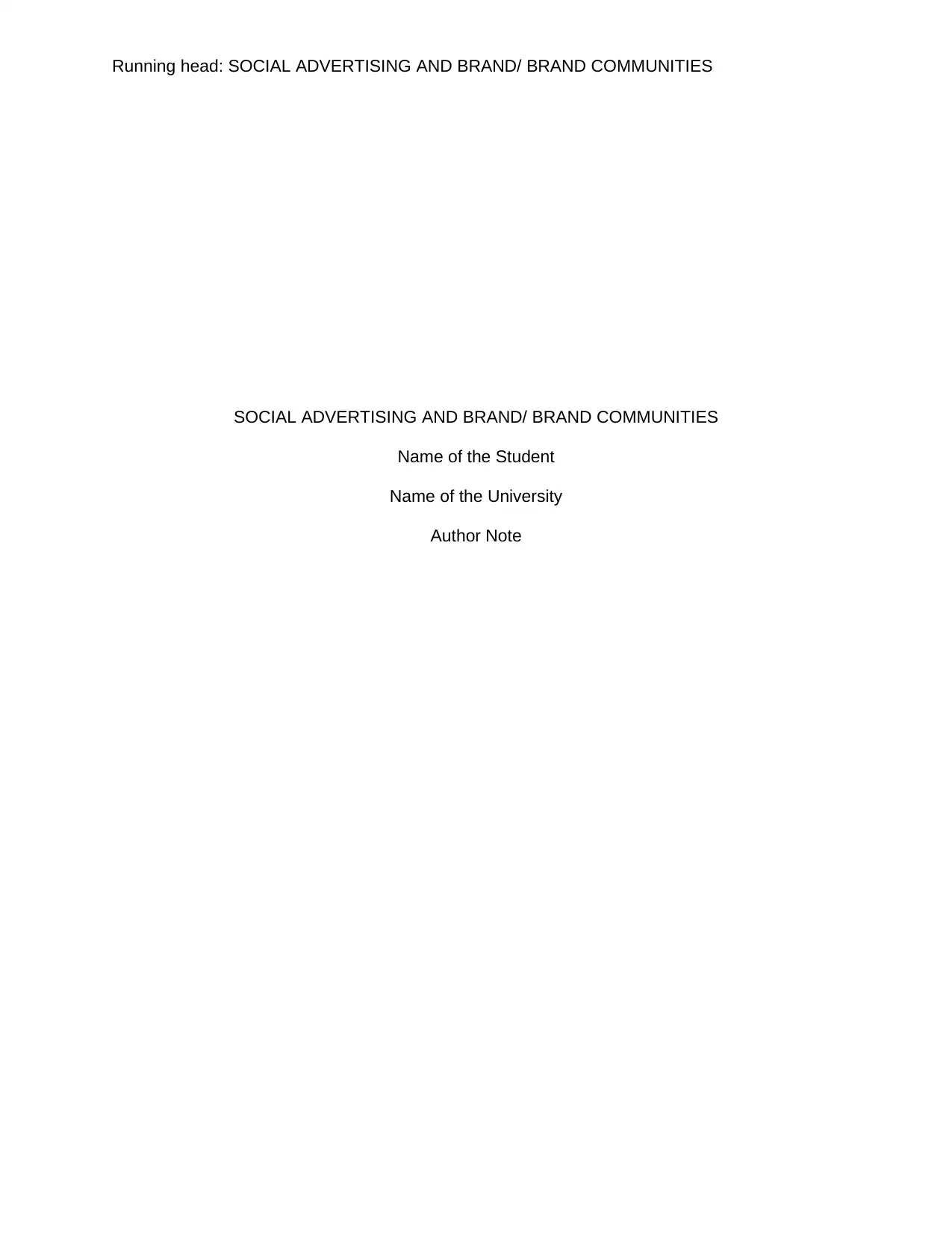
Running head: SOCIAL ADVERTISING AND BRAND/ BRAND COMMUNITIES
SOCIAL ADVERTISING AND BRAND/ BRAND COMMUNITIES
Name of the Student
Name of the University
Author Note
SOCIAL ADVERTISING AND BRAND/ BRAND COMMUNITIES
Name of the Student
Name of the University
Author Note
Paraphrase This Document
Need a fresh take? Get an instant paraphrase of this document with our AI Paraphraser
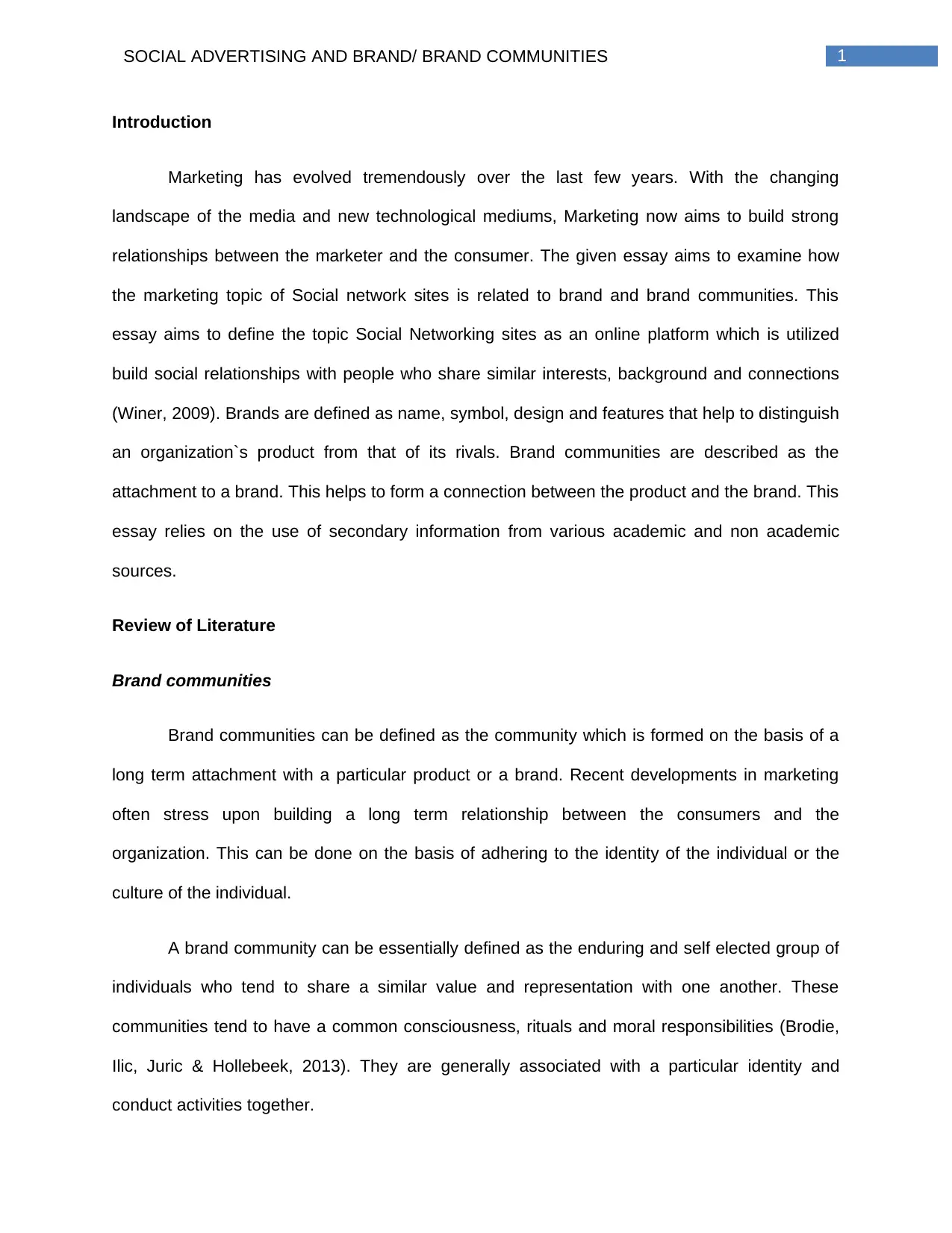
1SOCIAL ADVERTISING AND BRAND/ BRAND COMMUNITIES
Introduction
Marketing has evolved tremendously over the last few years. With the changing
landscape of the media and new technological mediums, Marketing now aims to build strong
relationships between the marketer and the consumer. The given essay aims to examine how
the marketing topic of Social network sites is related to brand and brand communities. This
essay aims to define the topic Social Networking sites as an online platform which is utilized
build social relationships with people who share similar interests, background and connections
(Winer, 2009). Brands are defined as name, symbol, design and features that help to distinguish
an organization`s product from that of its rivals. Brand communities are described as the
attachment to a brand. This helps to form a connection between the product and the brand. This
essay relies on the use of secondary information from various academic and non academic
sources.
Review of Literature
Brand communities
Brand communities can be defined as the community which is formed on the basis of a
long term attachment with a particular product or a brand. Recent developments in marketing
often stress upon building a long term relationship between the consumers and the
organization. This can be done on the basis of adhering to the identity of the individual or the
culture of the individual.
A brand community can be essentially defined as the enduring and self elected group of
individuals who tend to share a similar value and representation with one another. These
communities tend to have a common consciousness, rituals and moral responsibilities (Brodie,
Ilic, Juric & Hollebeek, 2013). They are generally associated with a particular identity and
conduct activities together.
Introduction
Marketing has evolved tremendously over the last few years. With the changing
landscape of the media and new technological mediums, Marketing now aims to build strong
relationships between the marketer and the consumer. The given essay aims to examine how
the marketing topic of Social network sites is related to brand and brand communities. This
essay aims to define the topic Social Networking sites as an online platform which is utilized
build social relationships with people who share similar interests, background and connections
(Winer, 2009). Brands are defined as name, symbol, design and features that help to distinguish
an organization`s product from that of its rivals. Brand communities are described as the
attachment to a brand. This helps to form a connection between the product and the brand. This
essay relies on the use of secondary information from various academic and non academic
sources.
Review of Literature
Brand communities
Brand communities can be defined as the community which is formed on the basis of a
long term attachment with a particular product or a brand. Recent developments in marketing
often stress upon building a long term relationship between the consumers and the
organization. This can be done on the basis of adhering to the identity of the individual or the
culture of the individual.
A brand community can be essentially defined as the enduring and self elected group of
individuals who tend to share a similar value and representation with one another. These
communities tend to have a common consciousness, rituals and moral responsibilities (Brodie,
Ilic, Juric & Hollebeek, 2013). They are generally associated with a particular identity and
conduct activities together.

2SOCIAL ADVERTISING AND BRAND/ BRAND COMMUNITIES
In relation to advertising and marketing, brand communities can be defined as the fans of the
brands and the people who tend to act as loyal customers. Having a small community can
convert the brand into a popular one and can bring about the success for it.
Brand communities generally come from a similar perspective of a particular objective.
Although it is often believed that brand communities are relatively a new concept but this is not
the case, the concept has been there since a long time and there have always been people who
have had faith in a particular brand and shared this liking with various other likeminded people
(Luo & Zhong, 2015).
There are various brands that provide this brand communities concept like Apple
products like Mac, iPhone, Holga, Lomo.
In vehicles, Mini Cooper, Royal Enfield, Harley Davidson motorcycles. In toys, there are Barbie
and Lego. Among the perspectives, it is often believed that brand communities can emerge not
only with respect to one brand but various brands in combination (Goh, Heng, & Lin, 2013).
Brand
A brand can be described as a symbol, design, term and other relevant features which
help to distinguish a particular product or an organization from that of its competitors in the eyes
of the consumers. Brand is primarily a popular concept in the domain of business and
advertising.
The branding practice began a long time back in Egyptians who engaged in life stock
branding. They used to brand their stock in order to differentiate one cattle from another. This
term then developed to become the strategic personality of a particular company and thus brand
suggests the values that the company may have to offer to the customers (Baldus, Voorhees &
Calantone, 2015).
In relation to advertising and marketing, brand communities can be defined as the fans of the
brands and the people who tend to act as loyal customers. Having a small community can
convert the brand into a popular one and can bring about the success for it.
Brand communities generally come from a similar perspective of a particular objective.
Although it is often believed that brand communities are relatively a new concept but this is not
the case, the concept has been there since a long time and there have always been people who
have had faith in a particular brand and shared this liking with various other likeminded people
(Luo & Zhong, 2015).
There are various brands that provide this brand communities concept like Apple
products like Mac, iPhone, Holga, Lomo.
In vehicles, Mini Cooper, Royal Enfield, Harley Davidson motorcycles. In toys, there are Barbie
and Lego. Among the perspectives, it is often believed that brand communities can emerge not
only with respect to one brand but various brands in combination (Goh, Heng, & Lin, 2013).
Brand
A brand can be described as a symbol, design, term and other relevant features which
help to distinguish a particular product or an organization from that of its competitors in the eyes
of the consumers. Brand is primarily a popular concept in the domain of business and
advertising.
The branding practice began a long time back in Egyptians who engaged in life stock
branding. They used to brand their stock in order to differentiate one cattle from another. This
term then developed to become the strategic personality of a particular company and thus brand
suggests the values that the company may have to offer to the customers (Baldus, Voorhees &
Calantone, 2015).
⊘ This is a preview!⊘
Do you want full access?
Subscribe today to unlock all pages.

Trusted by 1+ million students worldwide
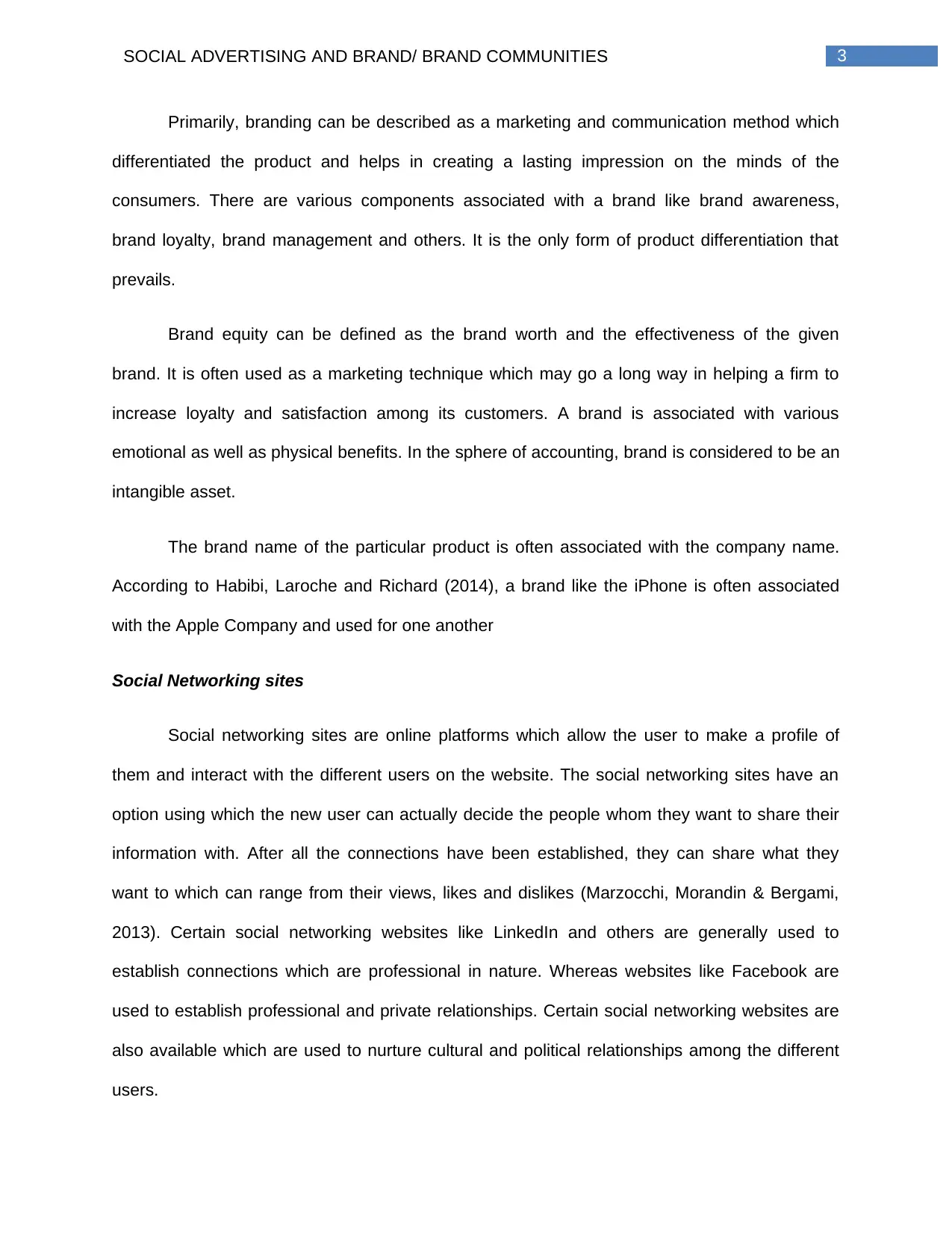
3SOCIAL ADVERTISING AND BRAND/ BRAND COMMUNITIES
Primarily, branding can be described as a marketing and communication method which
differentiated the product and helps in creating a lasting impression on the minds of the
consumers. There are various components associated with a brand like brand awareness,
brand loyalty, brand management and others. It is the only form of product differentiation that
prevails.
Brand equity can be defined as the brand worth and the effectiveness of the given
brand. It is often used as a marketing technique which may go a long way in helping a firm to
increase loyalty and satisfaction among its customers. A brand is associated with various
emotional as well as physical benefits. In the sphere of accounting, brand is considered to be an
intangible asset.
The brand name of the particular product is often associated with the company name.
According to Habibi, Laroche and Richard (2014), a brand like the iPhone is often associated
with the Apple Company and used for one another
Social Networking sites
Social networking sites are online platforms which allow the user to make a profile of
them and interact with the different users on the website. The social networking sites have an
option using which the new user can actually decide the people whom they want to share their
information with. After all the connections have been established, they can share what they
want to which can range from their views, likes and dislikes (Marzocchi, Morandin & Bergami,
2013). Certain social networking websites like LinkedIn and others are generally used to
establish connections which are professional in nature. Whereas websites like Facebook are
used to establish professional and private relationships. Certain social networking websites are
also available which are used to nurture cultural and political relationships among the different
users.
Primarily, branding can be described as a marketing and communication method which
differentiated the product and helps in creating a lasting impression on the minds of the
consumers. There are various components associated with a brand like brand awareness,
brand loyalty, brand management and others. It is the only form of product differentiation that
prevails.
Brand equity can be defined as the brand worth and the effectiveness of the given
brand. It is often used as a marketing technique which may go a long way in helping a firm to
increase loyalty and satisfaction among its customers. A brand is associated with various
emotional as well as physical benefits. In the sphere of accounting, brand is considered to be an
intangible asset.
The brand name of the particular product is often associated with the company name.
According to Habibi, Laroche and Richard (2014), a brand like the iPhone is often associated
with the Apple Company and used for one another
Social Networking sites
Social networking sites are online platforms which allow the user to make a profile of
them and interact with the different users on the website. The social networking sites have an
option using which the new user can actually decide the people whom they want to share their
information with. After all the connections have been established, they can share what they
want to which can range from their views, likes and dislikes (Marzocchi, Morandin & Bergami,
2013). Certain social networking websites like LinkedIn and others are generally used to
establish connections which are professional in nature. Whereas websites like Facebook are
used to establish professional and private relationships. Certain social networking websites are
also available which are used to nurture cultural and political relationships among the different
users.
Paraphrase This Document
Need a fresh take? Get an instant paraphrase of this document with our AI Paraphraser
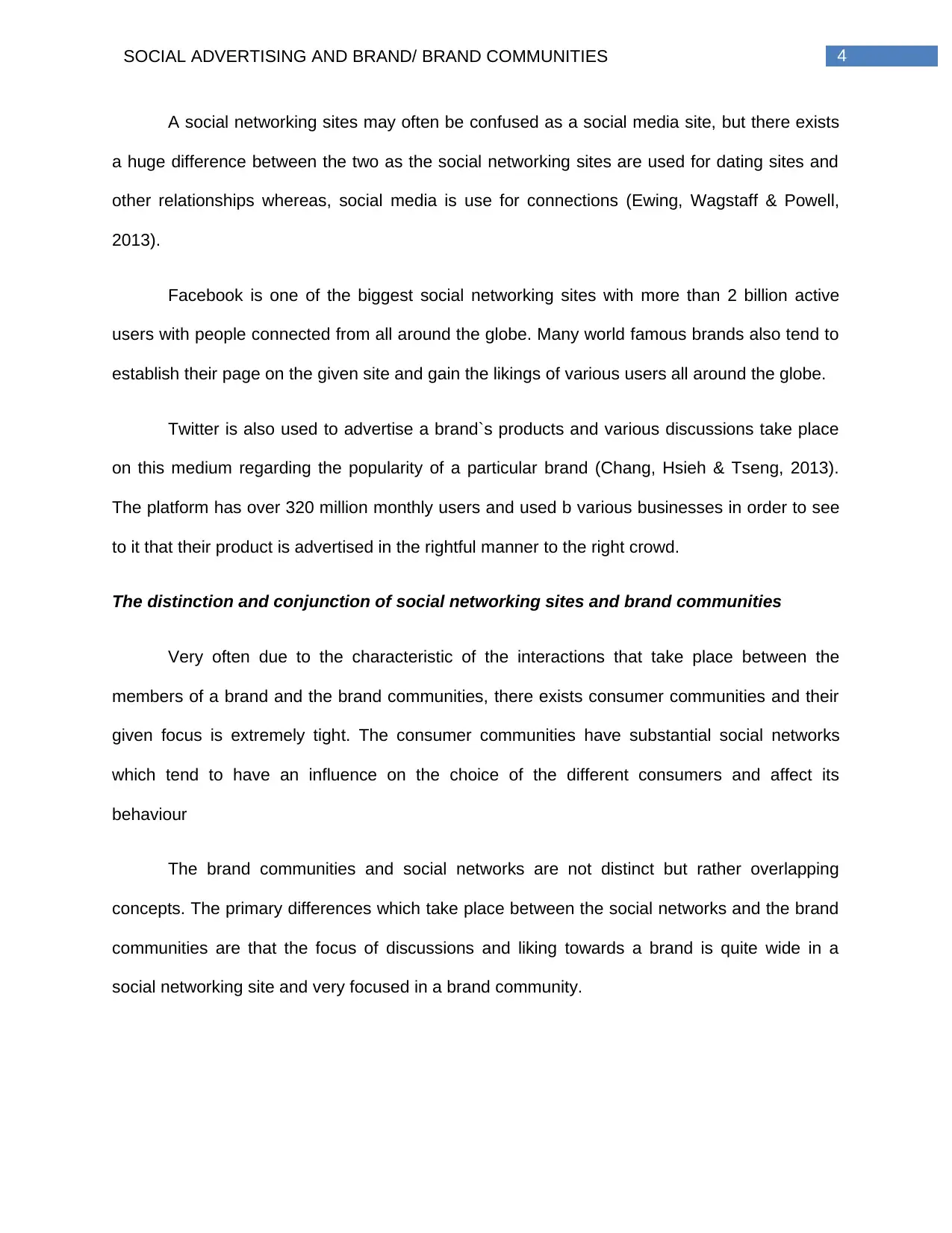
4SOCIAL ADVERTISING AND BRAND/ BRAND COMMUNITIES
A social networking sites may often be confused as a social media site, but there exists
a huge difference between the two as the social networking sites are used for dating sites and
other relationships whereas, social media is use for connections (Ewing, Wagstaff & Powell,
2013).
Facebook is one of the biggest social networking sites with more than 2 billion active
users with people connected from all around the globe. Many world famous brands also tend to
establish their page on the given site and gain the likings of various users all around the globe.
Twitter is also used to advertise a brand`s products and various discussions take place
on this medium regarding the popularity of a particular brand (Chang, Hsieh & Tseng, 2013).
The platform has over 320 million monthly users and used b various businesses in order to see
to it that their product is advertised in the rightful manner to the right crowd.
The distinction and conjunction of social networking sites and brand communities
Very often due to the characteristic of the interactions that take place between the
members of a brand and the brand communities, there exists consumer communities and their
given focus is extremely tight. The consumer communities have substantial social networks
which tend to have an influence on the choice of the different consumers and affect its
behaviour
The brand communities and social networks are not distinct but rather overlapping
concepts. The primary differences which take place between the social networks and the brand
communities are that the focus of discussions and liking towards a brand is quite wide in a
social networking site and very focused in a brand community.
A social networking sites may often be confused as a social media site, but there exists
a huge difference between the two as the social networking sites are used for dating sites and
other relationships whereas, social media is use for connections (Ewing, Wagstaff & Powell,
2013).
Facebook is one of the biggest social networking sites with more than 2 billion active
users with people connected from all around the globe. Many world famous brands also tend to
establish their page on the given site and gain the likings of various users all around the globe.
Twitter is also used to advertise a brand`s products and various discussions take place
on this medium regarding the popularity of a particular brand (Chang, Hsieh & Tseng, 2013).
The platform has over 320 million monthly users and used b various businesses in order to see
to it that their product is advertised in the rightful manner to the right crowd.
The distinction and conjunction of social networking sites and brand communities
Very often due to the characteristic of the interactions that take place between the
members of a brand and the brand communities, there exists consumer communities and their
given focus is extremely tight. The consumer communities have substantial social networks
which tend to have an influence on the choice of the different consumers and affect its
behaviour
The brand communities and social networks are not distinct but rather overlapping
concepts. The primary differences which take place between the social networks and the brand
communities are that the focus of discussions and liking towards a brand is quite wide in a
social networking site and very focused in a brand community.
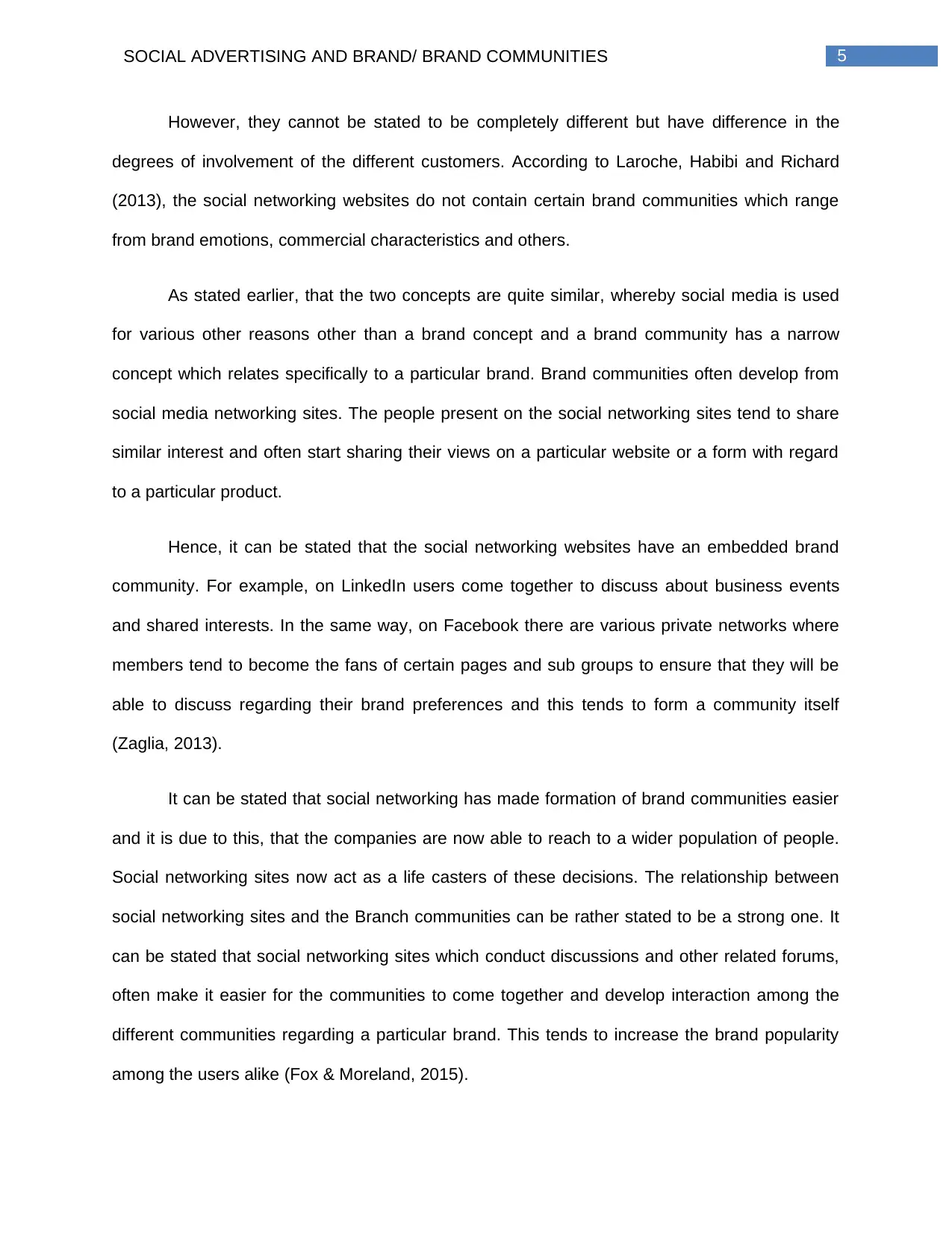
5SOCIAL ADVERTISING AND BRAND/ BRAND COMMUNITIES
However, they cannot be stated to be completely different but have difference in the
degrees of involvement of the different customers. According to Laroche, Habibi and Richard
(2013), the social networking websites do not contain certain brand communities which range
from brand emotions, commercial characteristics and others.
As stated earlier, that the two concepts are quite similar, whereby social media is used
for various other reasons other than a brand concept and a brand community has a narrow
concept which relates specifically to a particular brand. Brand communities often develop from
social media networking sites. The people present on the social networking sites tend to share
similar interest and often start sharing their views on a particular website or a form with regard
to a particular product.
Hence, it can be stated that the social networking websites have an embedded brand
community. For example, on LinkedIn users come together to discuss about business events
and shared interests. In the same way, on Facebook there are various private networks where
members tend to become the fans of certain pages and sub groups to ensure that they will be
able to discuss regarding their brand preferences and this tends to form a community itself
(Zaglia, 2013).
It can be stated that social networking has made formation of brand communities easier
and it is due to this, that the companies are now able to reach to a wider population of people.
Social networking sites now act as a life casters of these decisions. The relationship between
social networking sites and the Branch communities can be rather stated to be a strong one. It
can be stated that social networking sites which conduct discussions and other related forums,
often make it easier for the communities to come together and develop interaction among the
different communities regarding a particular brand. This tends to increase the brand popularity
among the users alike (Fox & Moreland, 2015).
However, they cannot be stated to be completely different but have difference in the
degrees of involvement of the different customers. According to Laroche, Habibi and Richard
(2013), the social networking websites do not contain certain brand communities which range
from brand emotions, commercial characteristics and others.
As stated earlier, that the two concepts are quite similar, whereby social media is used
for various other reasons other than a brand concept and a brand community has a narrow
concept which relates specifically to a particular brand. Brand communities often develop from
social media networking sites. The people present on the social networking sites tend to share
similar interest and often start sharing their views on a particular website or a form with regard
to a particular product.
Hence, it can be stated that the social networking websites have an embedded brand
community. For example, on LinkedIn users come together to discuss about business events
and shared interests. In the same way, on Facebook there are various private networks where
members tend to become the fans of certain pages and sub groups to ensure that they will be
able to discuss regarding their brand preferences and this tends to form a community itself
(Zaglia, 2013).
It can be stated that social networking has made formation of brand communities easier
and it is due to this, that the companies are now able to reach to a wider population of people.
Social networking sites now act as a life casters of these decisions. The relationship between
social networking sites and the Branch communities can be rather stated to be a strong one. It
can be stated that social networking sites which conduct discussions and other related forums,
often make it easier for the communities to come together and develop interaction among the
different communities regarding a particular brand. This tends to increase the brand popularity
among the users alike (Fox & Moreland, 2015).
⊘ This is a preview!⊘
Do you want full access?
Subscribe today to unlock all pages.

Trusted by 1+ million students worldwide
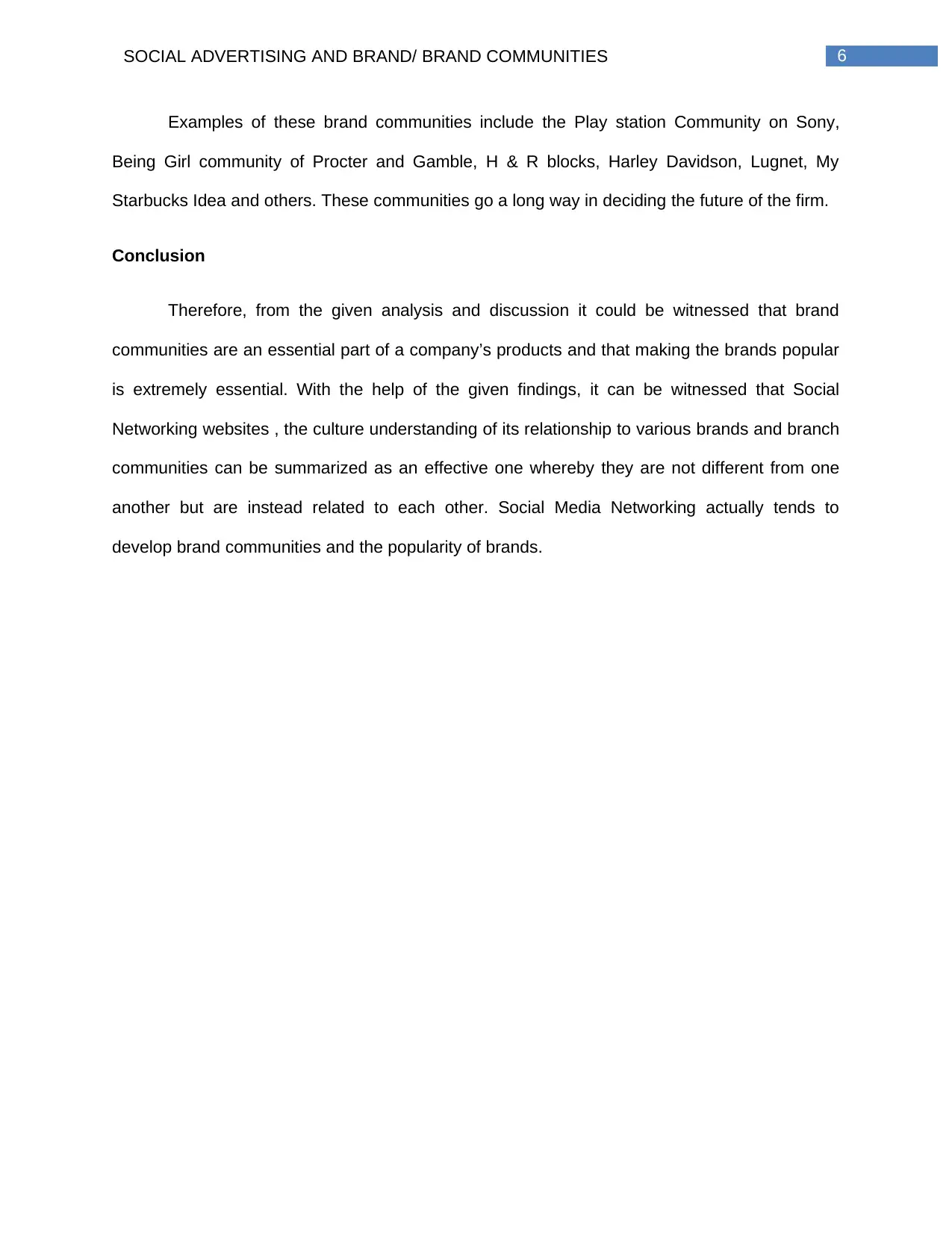
6SOCIAL ADVERTISING AND BRAND/ BRAND COMMUNITIES
Examples of these brand communities include the Play station Community on Sony,
Being Girl community of Procter and Gamble, H & R blocks, Harley Davidson, Lugnet, My
Starbucks Idea and others. These communities go a long way in deciding the future of the firm.
Conclusion
Therefore, from the given analysis and discussion it could be witnessed that brand
communities are an essential part of a company’s products and that making the brands popular
is extremely essential. With the help of the given findings, it can be witnessed that Social
Networking websites , the culture understanding of its relationship to various brands and branch
communities can be summarized as an effective one whereby they are not different from one
another but are instead related to each other. Social Media Networking actually tends to
develop brand communities and the popularity of brands.
Examples of these brand communities include the Play station Community on Sony,
Being Girl community of Procter and Gamble, H & R blocks, Harley Davidson, Lugnet, My
Starbucks Idea and others. These communities go a long way in deciding the future of the firm.
Conclusion
Therefore, from the given analysis and discussion it could be witnessed that brand
communities are an essential part of a company’s products and that making the brands popular
is extremely essential. With the help of the given findings, it can be witnessed that Social
Networking websites , the culture understanding of its relationship to various brands and branch
communities can be summarized as an effective one whereby they are not different from one
another but are instead related to each other. Social Media Networking actually tends to
develop brand communities and the popularity of brands.
Paraphrase This Document
Need a fresh take? Get an instant paraphrase of this document with our AI Paraphraser
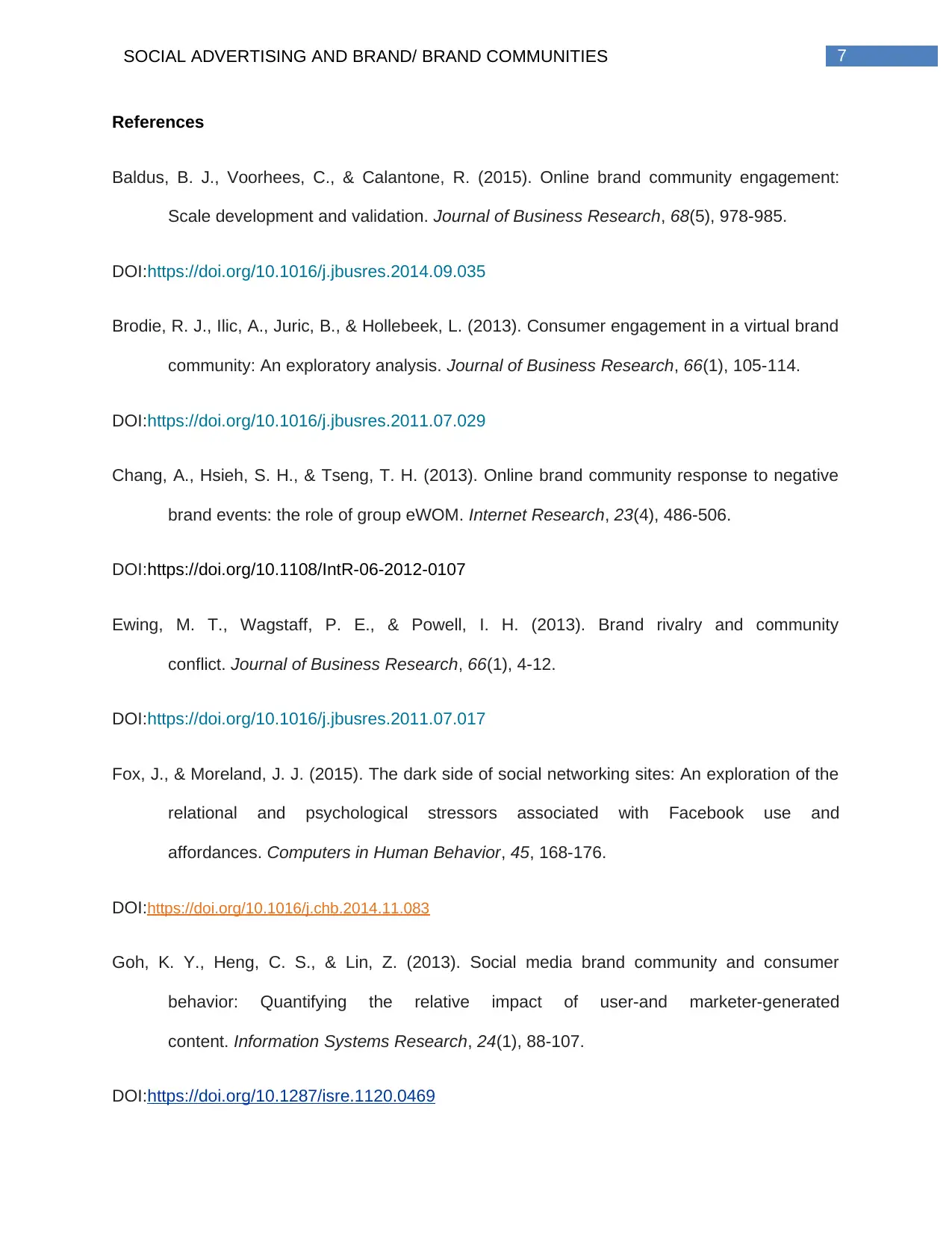
7SOCIAL ADVERTISING AND BRAND/ BRAND COMMUNITIES
References
Baldus, B. J., Voorhees, C., & Calantone, R. (2015). Online brand community engagement:
Scale development and validation. Journal of Business Research, 68(5), 978-985.
DOI:https://doi.org/10.1016/j.jbusres.2014.09.035
Brodie, R. J., Ilic, A., Juric, B., & Hollebeek, L. (2013). Consumer engagement in a virtual brand
community: An exploratory analysis. Journal of Business Research, 66(1), 105-114.
DOI:https://doi.org/10.1016/j.jbusres.2011.07.029
Chang, A., Hsieh, S. H., & Tseng, T. H. (2013). Online brand community response to negative
brand events: the role of group eWOM. Internet Research, 23(4), 486-506.
DOI:https://doi.org/10.1108/IntR-06-2012-0107
Ewing, M. T., Wagstaff, P. E., & Powell, I. H. (2013). Brand rivalry and community
conflict. Journal of Business Research, 66(1), 4-12.
DOI:https://doi.org/10.1016/j.jbusres.2011.07.017
Fox, J., & Moreland, J. J. (2015). The dark side of social networking sites: An exploration of the
relational and psychological stressors associated with Facebook use and
affordances. Computers in Human Behavior, 45, 168-176.
DOI:https://doi.org/10.1016/j.chb.2014.11.083
Goh, K. Y., Heng, C. S., & Lin, Z. (2013). Social media brand community and consumer
behavior: Quantifying the relative impact of user-and marketer-generated
content. Information Systems Research, 24(1), 88-107.
DOI:https://doi.org/10.1287/isre.1120.0469
References
Baldus, B. J., Voorhees, C., & Calantone, R. (2015). Online brand community engagement:
Scale development and validation. Journal of Business Research, 68(5), 978-985.
DOI:https://doi.org/10.1016/j.jbusres.2014.09.035
Brodie, R. J., Ilic, A., Juric, B., & Hollebeek, L. (2013). Consumer engagement in a virtual brand
community: An exploratory analysis. Journal of Business Research, 66(1), 105-114.
DOI:https://doi.org/10.1016/j.jbusres.2011.07.029
Chang, A., Hsieh, S. H., & Tseng, T. H. (2013). Online brand community response to negative
brand events: the role of group eWOM. Internet Research, 23(4), 486-506.
DOI:https://doi.org/10.1108/IntR-06-2012-0107
Ewing, M. T., Wagstaff, P. E., & Powell, I. H. (2013). Brand rivalry and community
conflict. Journal of Business Research, 66(1), 4-12.
DOI:https://doi.org/10.1016/j.jbusres.2011.07.017
Fox, J., & Moreland, J. J. (2015). The dark side of social networking sites: An exploration of the
relational and psychological stressors associated with Facebook use and
affordances. Computers in Human Behavior, 45, 168-176.
DOI:https://doi.org/10.1016/j.chb.2014.11.083
Goh, K. Y., Heng, C. S., & Lin, Z. (2013). Social media brand community and consumer
behavior: Quantifying the relative impact of user-and marketer-generated
content. Information Systems Research, 24(1), 88-107.
DOI:https://doi.org/10.1287/isre.1120.0469
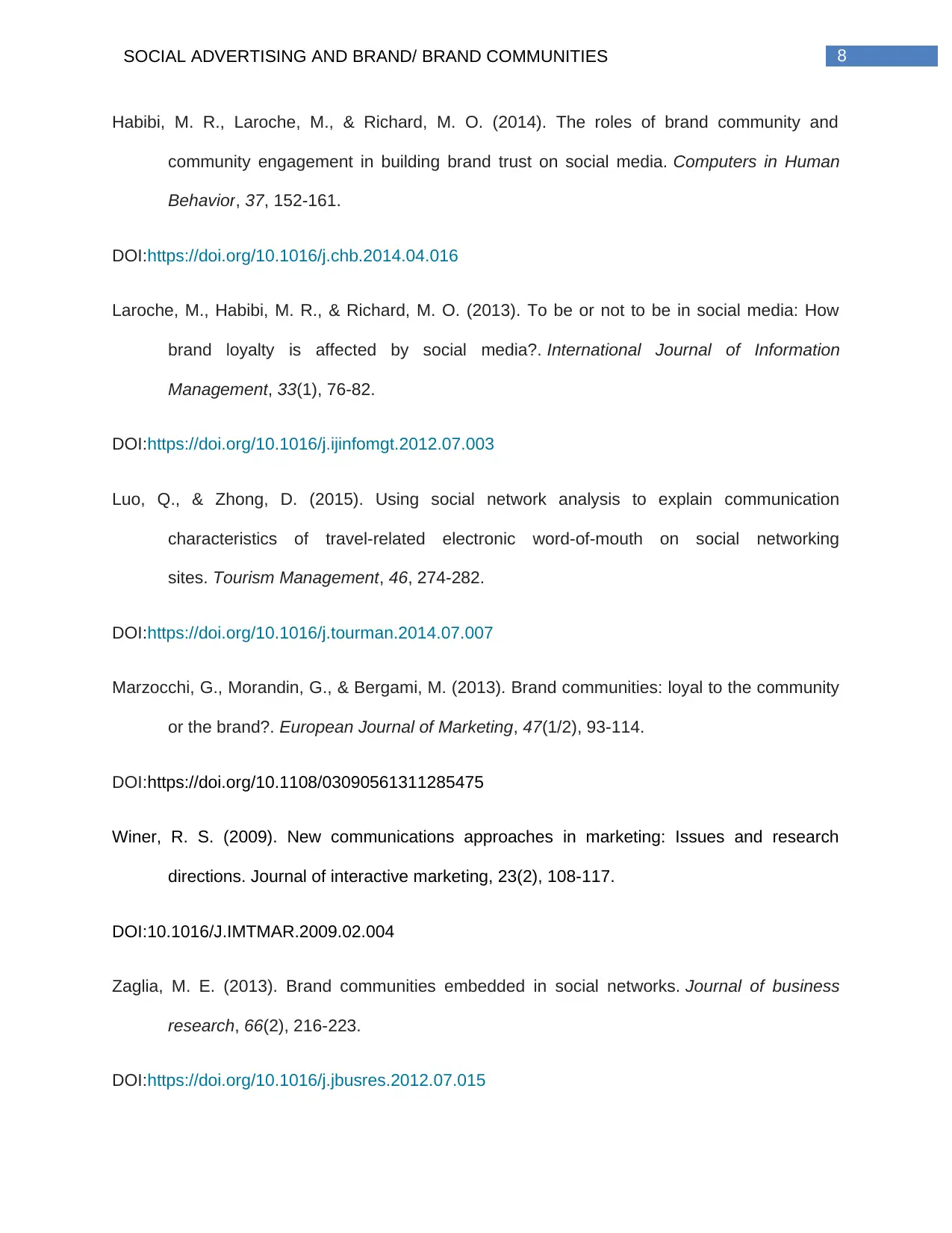
8SOCIAL ADVERTISING AND BRAND/ BRAND COMMUNITIES
Habibi, M. R., Laroche, M., & Richard, M. O. (2014). The roles of brand community and
community engagement in building brand trust on social media. Computers in Human
Behavior, 37, 152-161.
DOI:https://doi.org/10.1016/j.chb.2014.04.016
Laroche, M., Habibi, M. R., & Richard, M. O. (2013). To be or not to be in social media: How
brand loyalty is affected by social media?. International Journal of Information
Management, 33(1), 76-82.
DOI:https://doi.org/10.1016/j.ijinfomgt.2012.07.003
Luo, Q., & Zhong, D. (2015). Using social network analysis to explain communication
characteristics of travel-related electronic word-of-mouth on social networking
sites. Tourism Management, 46, 274-282.
DOI:https://doi.org/10.1016/j.tourman.2014.07.007
Marzocchi, G., Morandin, G., & Bergami, M. (2013). Brand communities: loyal to the community
or the brand?. European Journal of Marketing, 47(1/2), 93-114.
DOI:https://doi.org/10.1108/03090561311285475
Winer, R. S. (2009). New communications approaches in marketing: Issues and research
directions. Journal of interactive marketing, 23(2), 108-117.
DOI:10.1016/J.IMTMAR.2009.02.004
Zaglia, M. E. (2013). Brand communities embedded in social networks. Journal of business
research, 66(2), 216-223.
DOI:https://doi.org/10.1016/j.jbusres.2012.07.015
Habibi, M. R., Laroche, M., & Richard, M. O. (2014). The roles of brand community and
community engagement in building brand trust on social media. Computers in Human
Behavior, 37, 152-161.
DOI:https://doi.org/10.1016/j.chb.2014.04.016
Laroche, M., Habibi, M. R., & Richard, M. O. (2013). To be or not to be in social media: How
brand loyalty is affected by social media?. International Journal of Information
Management, 33(1), 76-82.
DOI:https://doi.org/10.1016/j.ijinfomgt.2012.07.003
Luo, Q., & Zhong, D. (2015). Using social network analysis to explain communication
characteristics of travel-related electronic word-of-mouth on social networking
sites. Tourism Management, 46, 274-282.
DOI:https://doi.org/10.1016/j.tourman.2014.07.007
Marzocchi, G., Morandin, G., & Bergami, M. (2013). Brand communities: loyal to the community
or the brand?. European Journal of Marketing, 47(1/2), 93-114.
DOI:https://doi.org/10.1108/03090561311285475
Winer, R. S. (2009). New communications approaches in marketing: Issues and research
directions. Journal of interactive marketing, 23(2), 108-117.
DOI:10.1016/J.IMTMAR.2009.02.004
Zaglia, M. E. (2013). Brand communities embedded in social networks. Journal of business
research, 66(2), 216-223.
DOI:https://doi.org/10.1016/j.jbusres.2012.07.015
⊘ This is a preview!⊘
Do you want full access?
Subscribe today to unlock all pages.

Trusted by 1+ million students worldwide
1 out of 9
Related Documents
Your All-in-One AI-Powered Toolkit for Academic Success.
+13062052269
info@desklib.com
Available 24*7 on WhatsApp / Email
![[object Object]](/_next/static/media/star-bottom.7253800d.svg)
Unlock your academic potential
Copyright © 2020–2025 A2Z Services. All Rights Reserved. Developed and managed by ZUCOL.





